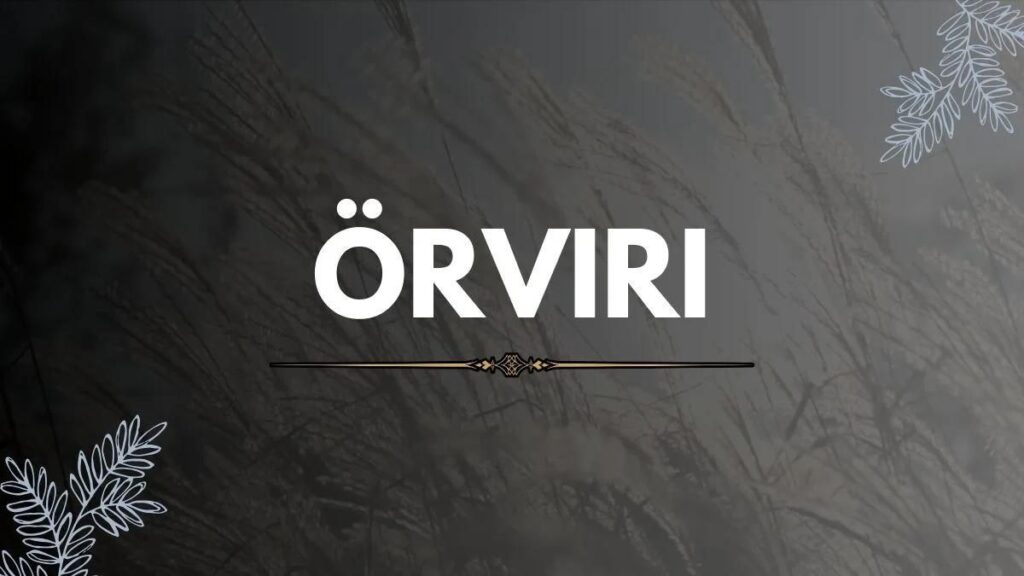Icelandic folklore is a treasure trove of mythical beings, weaving tales of creatures that roam the wild landscapes and haunt the imagination of locals and visitors alike. Among these enigmatic figures, Örvíri stands out as one of the most intriguing. In this comprehensive exploration, we’ll delve deep into the origins, characteristics, stories, cultural significance, and modern interpretations of Örvíri, shedding light on this mysterious entity from Icelandic mythology.
Origins of Örvíri
To understand Örvíri, we must first delve into its ancient origins within Icelandic mythology. References to Örvíri are found in historical texts and sagas, where it is depicted as a supernatural being, closely tied to the natural world and the forces of nature. While exact origins are shrouded in mystery, Örvíri is believed to have roots in the early beliefs and superstitions of Icelanders.
The name Örvíri itself is evocative, often translated as “wind whirl” or “storm wind,” suggesting a connection to the elements and the untamed forces of the Icelandic wilderness. This association with nature underscores Örvíri’s significance as a symbol of the rugged landscape and unpredictable climate of Iceland.
Characteristics of Örvíri
Örvíri is described in Icelandic folklore as a shapeshifting entity, capable of assuming various forms. It is often depicted as a tall, shadowy figure with piercing, glowing eyes, lurking in the remote corners of the Icelandic wilderness. Despite its fearsome appearance, Örvíri is said to possess an otherworldly elegance and grace, moving silently through the landscape like a specter of the wild.
In some stories, Örvíri is described as having the ability to control the weather, conjuring storms or calm at will. This association with natural phenomena further cements Örvíri’s status as a powerful and mysterious figure in Icelandic folklore.
Stories and Legends
Throughout Icelandic history, Örvíri has been a recurring character in folk tales and legends, captivating audiences with its enigmatic nature and unpredictable behavior. One such tale tells of Örvíri’s encounters with travelers, where it would appear suddenly, either to aid or hinder them on their journeys.
In some stories, Örvíri is depicted as a benevolent guardian of the wilderness, guiding lost travelers to safety or warning them of impending danger. However, other tales portray Örvíri as a malevolent force, leading travelers astray or luring them into treacherous terrain.
These stories served as cautionary warnings, reminding people to respect the power of nature and the unknown. They also reflect the Icelandic people’s deep connection to the land and their reverence for its mysteries.
Örvíri in Modern Culture
Despite the passage of time, Örvíri continues to hold a prominent place in Icelandic culture. Its influence can be seen in literature, art, and media, where it often symbolizes the untamed wilderness and the mysteries of the natural world.
In literature, Örvíri appears in contemporary works that draw inspiration from Icelandic folklore, adding depth and authenticity to modern storytelling. Artists and filmmakers also incorporate Örvíri into their creations, capturing its eerie allure and mystical presence on canvas and screen.
Moreover, Örvíri is celebrated in cultural events and festivals throughout Iceland, where folklore enthusiasts gather to share stories, music, and traditions passed down through generations. These events serve to keep Örvíri’s legacy alive and foster a deeper appreciation for Icelandic folklore and heritage.
Theories and Interpretations
Interpretations of Örvíri vary among scholars and enthusiasts, adding to its mystique and allure. Some see it as a representation of Iceland’s rugged landscape and harsh climate, embodying the wild and untamed spirit of the country. Others view Örvíri as a symbol of the supernatural forces that govern the world, a mysterious guardian of nature’s secrets.
Additionally, Örvíri’s shapeshifting abilities and elusive nature have led to interpretations that liken it to trickster figures found in other mythologies. It is often compared to creatures like the Celtic Púca or the Scandinavian Huldra, further blurring the lines between folklore traditions and highlighting the universal themes found in myth and legend.
Örvíri’s Connection to Other Icelandic Folklore
In Icelandic folklore, Örvíri is often mentioned alongside other mythical beings, such as elves, trolls, and ghosts. While these creatures share similarities, Örvíri stands out for its unique role as a guardian of the wilderness.
Elves, known as álfar in Icelandic, are often depicted as beings of light and beauty, dwelling in hidden communities within the Icelandic landscape. Trolls, on the other hand, are creatures of darkness and chaos, known for their brutish appearance and destructive tendencies. Örvíri’s connection to these beings reflects the complex relationship between humans and the supernatural world in Icelandic folklore, where the boundaries between friend and foe are often blurred.
Folklore Tourism and Örvíri
The allure of Icelandic folklore, including tales of Örvíri, has not gone unnoticed by the tourism industry. Travelers from around the world are drawn to Iceland’s rugged beauty and rich cultural heritage, seeking out experiences that immerse them in the country’s mythical past.
Folklore tours offer visitors the opportunity to explore the landscapes and landmarks associated with Örvíri and other mythical beings. These tours often include visits to remote locations, such as lava fields, waterfalls, and ancient ruins, where travelers can learn about the legends and stories that have shaped Icelandic culture for centuries.
Additionally, museums and cultural centers across Iceland feature exhibits dedicated to Icelandic folklore, providing visitors with insights into the history, traditions, and beliefs of the Icelandic people. These attractions serve as gateways to the world of Örvíri, sparking curiosity and fascination among tourists eager to uncover the secrets of Icelandic mythology.
Protecting Örvíri’s Legacy
As Icelandic society evolves and modernizes, efforts are underway to preserve the country’s folklore traditions, ensuring that the stories of Örvíri and other mythical beings endure for future generations. Organizations dedicated to folklore research and education work tirelessly to collect and document oral traditions, manuscripts, and artifacts related to Icelandic mythology.
These efforts are essential for maintaining Iceland’s unique cultural identity and fostering a sense of pride and connection among its people. By safeguarding Örvíri’s legacy, Iceland honors its past and preserves the rich tapestry of its folklore heritage for generations to come.
Conclusion
Örvíri remains a captivating and enigmatic figure in Icelandic folklore, embodying the mystique and wonder of the country’s natural landscapes. Through its tales and legends, Örvíri invites us to explore the depths of Icelandic mythology, where the line between reality and fantasy blurs, and the mysteries of the wilderness come alive.
As we continue to delve into the rich tapestry of Icelandic folklore, Örvíri serves as a reminder of the enduring power of storytelling and the importance of preserving our cultural heritage. Whether viewed as a guardian of the wilderness, a trickster of the elements, or a symbol of the unknown, Örvíri will continue to fascinate and inspire generations to come, keeping the spirit of Icelandic mythology alive for centuries to come.







